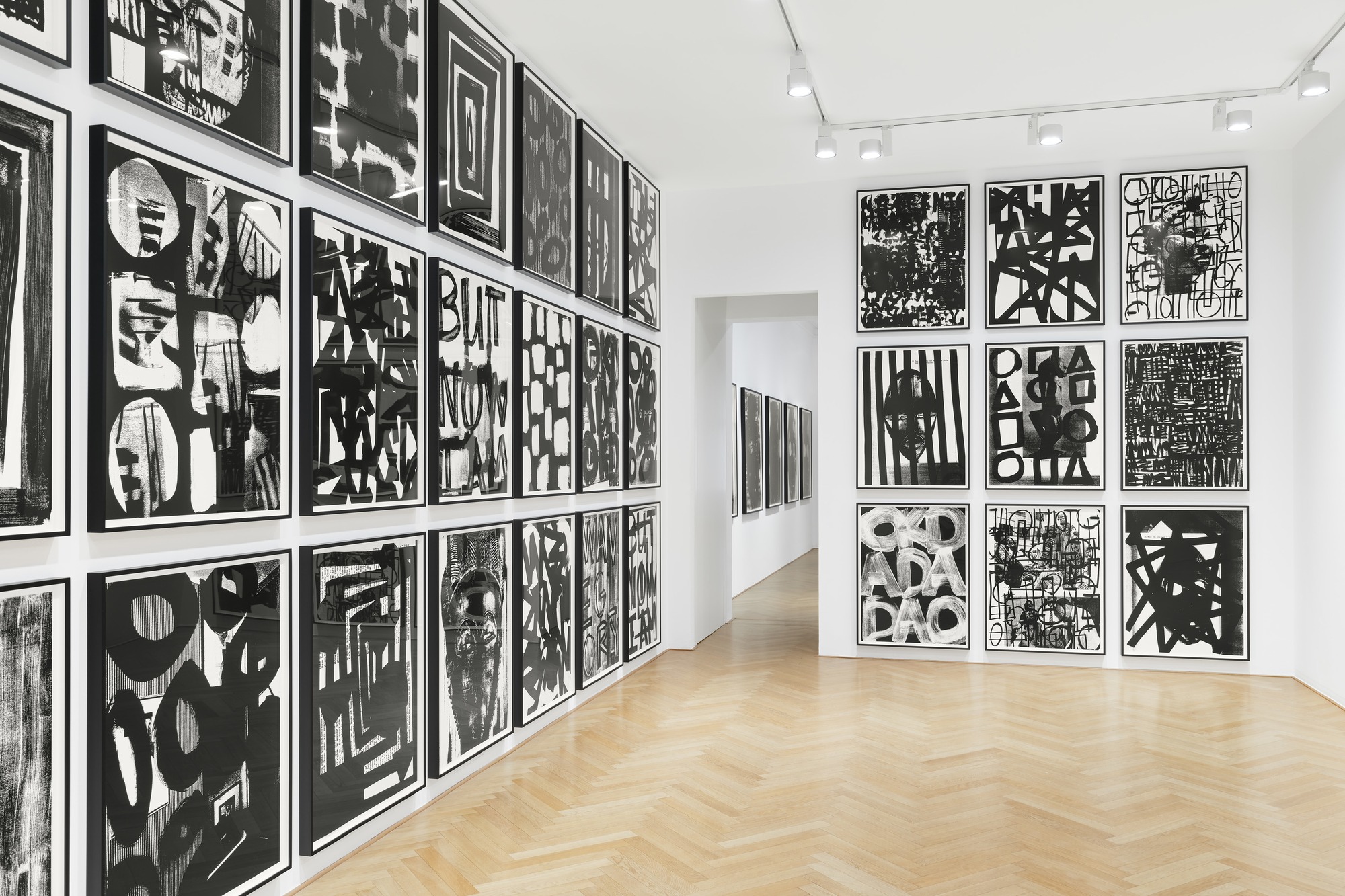Adam Pendleton
Who We Are
25 Apr - 29 Jun 2019
ADAM PENDLETON
Who We Are
25 April – 29 June 2019
Galerie Max Hetzler is pleased to announce Who We Are, with new work by Adam Pendleton in both its Berlin locations: Bleibtreustraße 45 and Goethestraße 2/3. This will be Pendleton’s first exhibition with the gallery.
Between 1979 and 1980, Julius Eastman composed Evil Nigger, Crazy Nigger, and Gay Guerrilla. In each work, four parallel pianos hammer pulsed, repetitive lines. Each piano comes in and out of synchronization.
1, 2, 3, 4!
In Adam Pendleton’s newest video portrait, Ishmael in the Garden: A Portrait of Ishmael Houston-Jones (2018), dancer and choreographer Ishmael Houston-Jones relates a series of memories: “I remember picking out the dress my mother wore at her funeral. I remember not liking the taste of milk that came right from the cows. I remember falling in and out of love. I remember...I remember censoring myself.”
“Who we are” posits a subject of enunciation in the first person plural.
The refrain echoes Just Back from Los Angeles: A Portrait of Yvonne Rainer (2016–17), in which Pendleton had asked dancer, choreographer, and filmmaker Yvonne Rainer to recite a list of recollections from a letter written to her in 1963 by Barbara Dilley. “I remember you grinning at the pleasure we had,” she reads. “I remember talking to you in the hotel. I remember standing around waiting to start the run-thru.”
“Who we are” posits a collective assemblage of enunciation.
1, 2, 3, 4!
Eastman’s compositions proceed according to a principle of non-dialectical organicism. The formal imperative of what Eastman called “organic music” was for each section of the piece to “contain all of the information of the previous sections,” or else to subtract information “at a gradual and logical rate.”
“Who we are” is a power to come or a force to be constructed.
The paintings layer repeating phrases: “WE ARE NOT,” and language that points to Eastman. The information is dense, striated in black and white. Each painting comes in and out of synchronization.
“Who we are” is mappable only as continuous iteration: overlapping series of conjectures, encounters, revisions.
– New York, April 2019
Adam Pendleton (*1984, Richmond, VA) is a New York-based artist known for work animated by what the artist calls “Black Dada,” a critical articulation of blackness, abstraction, and the avant-garde. Drawing from an archive of language and images, Pendleton makes conceptually rigorous and formally inventive paintings, collages, videos, and installations that insert his work into broader conversations about history and contemporary culture. His work is held in public collections including The Museum of Modern Art, New York; Solomon R. Guggenheim Museum, New York; Carnegie Museum of Art, Pittsburgh; Museum of Contemporary Art, Chicago; Museum of Contemporary Art, San Diego; The Studio Museum in Harlem, New York; and Tate, London, among others.
Who We Are
25 April – 29 June 2019
Galerie Max Hetzler is pleased to announce Who We Are, with new work by Adam Pendleton in both its Berlin locations: Bleibtreustraße 45 and Goethestraße 2/3. This will be Pendleton’s first exhibition with the gallery.
Between 1979 and 1980, Julius Eastman composed Evil Nigger, Crazy Nigger, and Gay Guerrilla. In each work, four parallel pianos hammer pulsed, repetitive lines. Each piano comes in and out of synchronization.
1, 2, 3, 4!
In Adam Pendleton’s newest video portrait, Ishmael in the Garden: A Portrait of Ishmael Houston-Jones (2018), dancer and choreographer Ishmael Houston-Jones relates a series of memories: “I remember picking out the dress my mother wore at her funeral. I remember not liking the taste of milk that came right from the cows. I remember falling in and out of love. I remember...I remember censoring myself.”
“Who we are” posits a subject of enunciation in the first person plural.
The refrain echoes Just Back from Los Angeles: A Portrait of Yvonne Rainer (2016–17), in which Pendleton had asked dancer, choreographer, and filmmaker Yvonne Rainer to recite a list of recollections from a letter written to her in 1963 by Barbara Dilley. “I remember you grinning at the pleasure we had,” she reads. “I remember talking to you in the hotel. I remember standing around waiting to start the run-thru.”
“Who we are” posits a collective assemblage of enunciation.
1, 2, 3, 4!
Eastman’s compositions proceed according to a principle of non-dialectical organicism. The formal imperative of what Eastman called “organic music” was for each section of the piece to “contain all of the information of the previous sections,” or else to subtract information “at a gradual and logical rate.”
“Who we are” is a power to come or a force to be constructed.
The paintings layer repeating phrases: “WE ARE NOT,” and language that points to Eastman. The information is dense, striated in black and white. Each painting comes in and out of synchronization.
“Who we are” is mappable only as continuous iteration: overlapping series of conjectures, encounters, revisions.
– New York, April 2019
Adam Pendleton (*1984, Richmond, VA) is a New York-based artist known for work animated by what the artist calls “Black Dada,” a critical articulation of blackness, abstraction, and the avant-garde. Drawing from an archive of language and images, Pendleton makes conceptually rigorous and formally inventive paintings, collages, videos, and installations that insert his work into broader conversations about history and contemporary culture. His work is held in public collections including The Museum of Modern Art, New York; Solomon R. Guggenheim Museum, New York; Carnegie Museum of Art, Pittsburgh; Museum of Contemporary Art, Chicago; Museum of Contemporary Art, San Diego; The Studio Museum in Harlem, New York; and Tate, London, among others.

